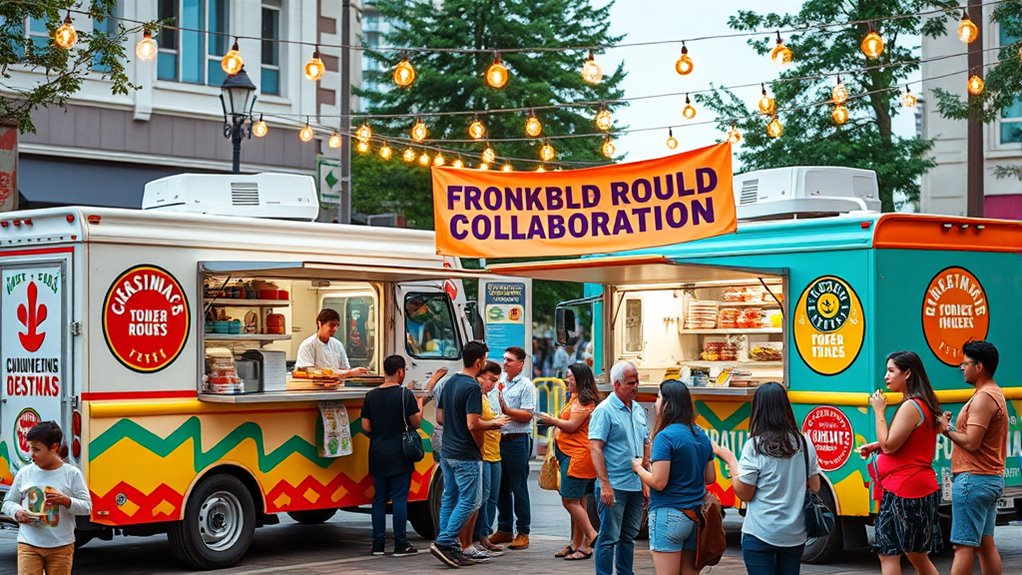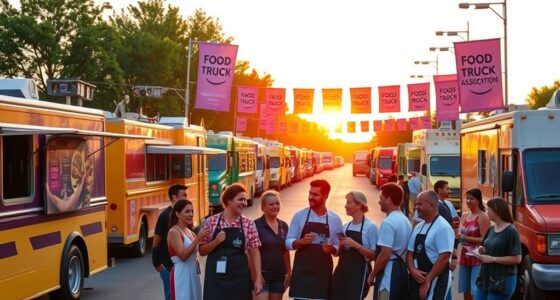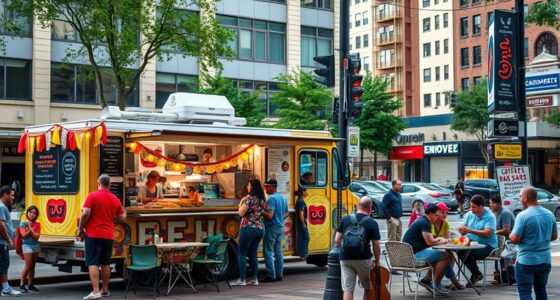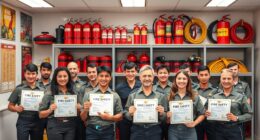Partnering with other food trucks and brands can boost your visibility, attract new customers, and create unique dining experiences. Focus on brands with aligned values and audiences to keep collaborations authentic. Use cross-promotions, joint events, and co-branded menu items to maximize exposure while sharing resources to cut costs. Make sure to plan carefully, handle legal details, and build strong relationships with partners. To discover effective strategies and real success stories, keep exploring further.
Key Takeaways
- Ensure brand alignment and shared values to create authentic, mutually beneficial partnerships.
- Select locations and events with high foot traffic that match your target audience.
- Use cross-promotional strategies like joint social media campaigns and co-branded merchandise to expand reach.
- Develop collaborative menu items or fusion dishes that showcase both brands’ identities.
- Establish clear agreements covering responsibilities, revenue sharing, permits, and liability for smooth collaboration.
Benefits of Partnering in the Food Truck Scene
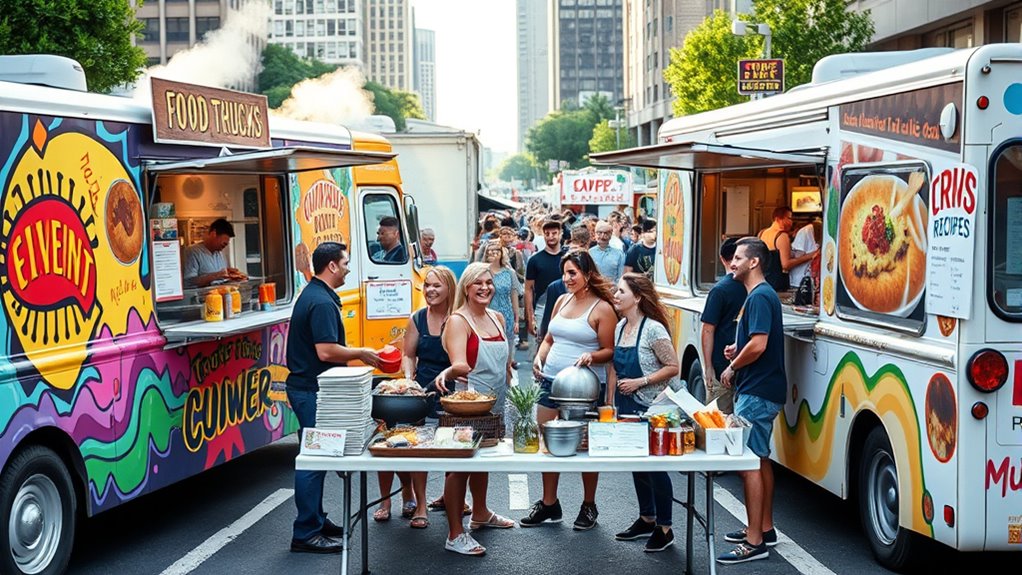
Partnering with other food trucks and brands can substantially boost your visibility and customer base. It enhances community engagement, allowing you to connect with local audiences and increase brand awareness. Collaborations often lead to shared marketing efforts, making social media strategies more effective. By teaming up, you can cross-promote each other’s offerings, expanding your reach without significant extra effort. These partnerships also create exciting opportunities for event participation, attracting diverse crowds and generating buzz. Additionally, working with like-minded brands fosters a sense of community and supports mutual growth. Your social media presence benefits from shared content, giving you fresh material to engage followers regularly. Overall, strategic collaborations strengthen your presence in the food truck scene and drive sustainable business growth.
Identifying the Right Collaboration Opportunities
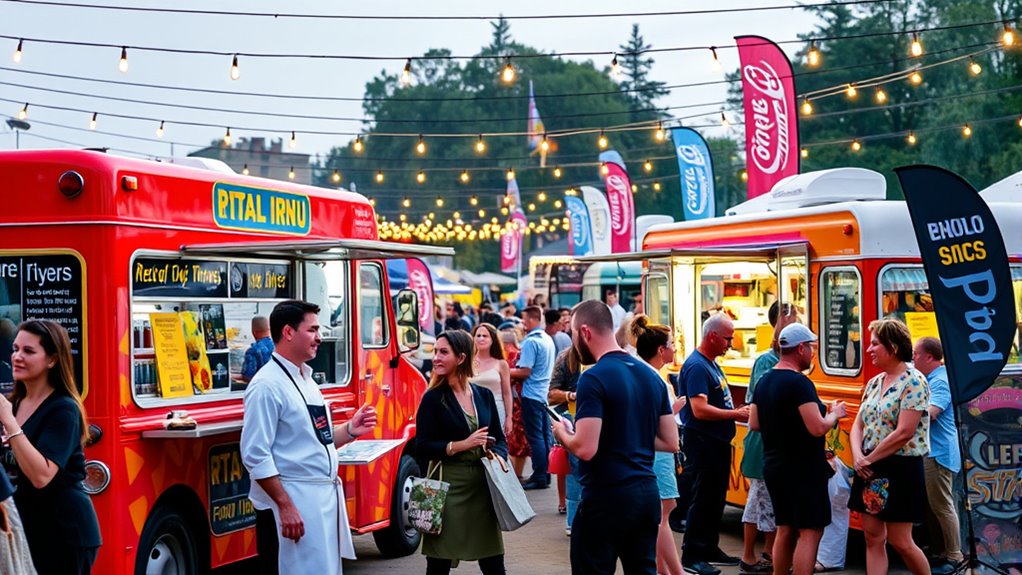
To find the right collaboration opportunities, you need to focus on brands whose values match your vision and guarantee your target audiences align. Consider whether the event or location suits both of your brands and can attract the right crowd. This way, your partnership will feel authentic and resonate with attendees. Additionally, assessing the personality traits of potential partners can help ensure a harmonious and effective collaboration.
Aligning Brand Values
Aligning brand values is essential for creating authentic collaborations that resonate with your audience. When your brand identity aligns with a partner’s, the partnership feels genuine and trustworthy. You should look for brands or food trucks that share similar missions, ethics, and customer values. This marketing alignment ensures that your audiences see a consistent message, strengthening your overall brand image. Consider how your values relate to theirs—whether it’s sustainability, community engagement, or quality. When these core principles match, your collaboration will naturally feel more sincere, making it easier to craft campaigns that truly connect. By focusing on shared values, you build partnerships that boost credibility and foster long-term loyalty, rather than just short-term gains. Additionally, understanding water-related concepts can help you incorporate eco-friendly practices into your collaborations, demonstrating your commitment to sustainability.
Target Audience Compatibility
Choosing the right collaboration opportunities means guaranteeing your partner’s audience matches your target market. To do this, analyze how their menu design appeals to your ideal customers and whether their offerings complement your cuisine. Consider whether their customer engagement strategies attract the same demographic you want to reach. If their audience is already interested in your type of food or experience, the partnership will naturally boost visibility and sales. Look for brands or trucks that serve a similar or complementary crowd, rather than a completely different one. This alignment ensures your collaboration feels authentic and resonates with your shared audience. By focusing on target audience compatibility, you maximize the impact of your joint efforts and create meaningful connections that benefit both brands. Additionally, understanding your audience’s preferences helps you tailor your collaboration strategies to better meet their needs.
Event and Location Fit
Selecting the right event and location for your collaboration is essential to maximizing visibility and engagement. Consider seasonal themes that align with your brand and attract the right crowd. For example, a summer outdoor festival or a winter holiday event can boost exposure. Geographic considerations are also vital; choose venues where your target audience is present and accessible. Partnering at a popular local market or a city-wide event can considerably increase foot traffic. Think about the event’s vibe and how it complements your food truck’s identity. The goal is to find opportunities that enhance your brand presence while appealing to the audience most likely to enjoy your offerings. When you match the event’s theme and location, your collaboration becomes more effective and memorable. Additionally, understanding the color accuracy of your promotional materials can help ensure your branding looks appealing and professional across all platforms.
Building Strong Relationships With Other Vendors
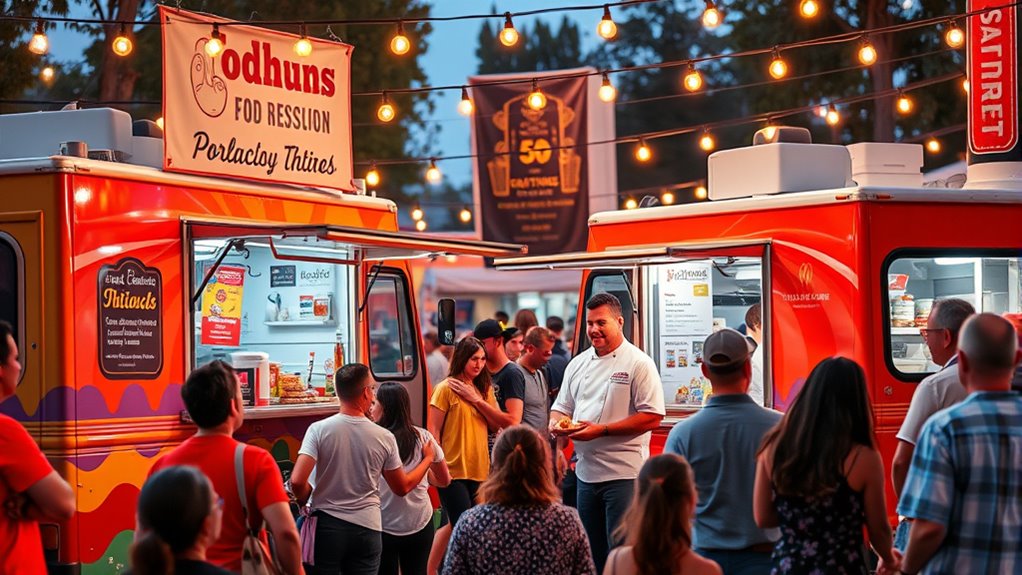
Building strong relationships with other vendors is essential for creating a successful food truck event. When you foster vendor loyalty, you encourage collaboration and support that benefits everyone. Engage actively on social media to showcase your partnerships and amplify your reach. To help you stay organized, consider this table:
| Vendor Type | Benefits of Collaboration | Engagement Strategies |
|---|---|---|
| Food Trucks | Increased visibility | Cross-promotions |
| Beverage Vendors | Shared customer base | Joint social media posts |
| Local Artisans | Unique event experience | Tagging and shout-outs |
| Event Organizers | Better event logistics | Regular communication |
Strong relationships lead to loyalty, better event dynamics, and a broader audience, making your event more memorable and successful. Additionally, understanding Louisiana Alimony Laws can help vendors better navigate financial arrangements and support structures for their staff and partners.
Creative Ways to Co-Brand and Cross-Promote
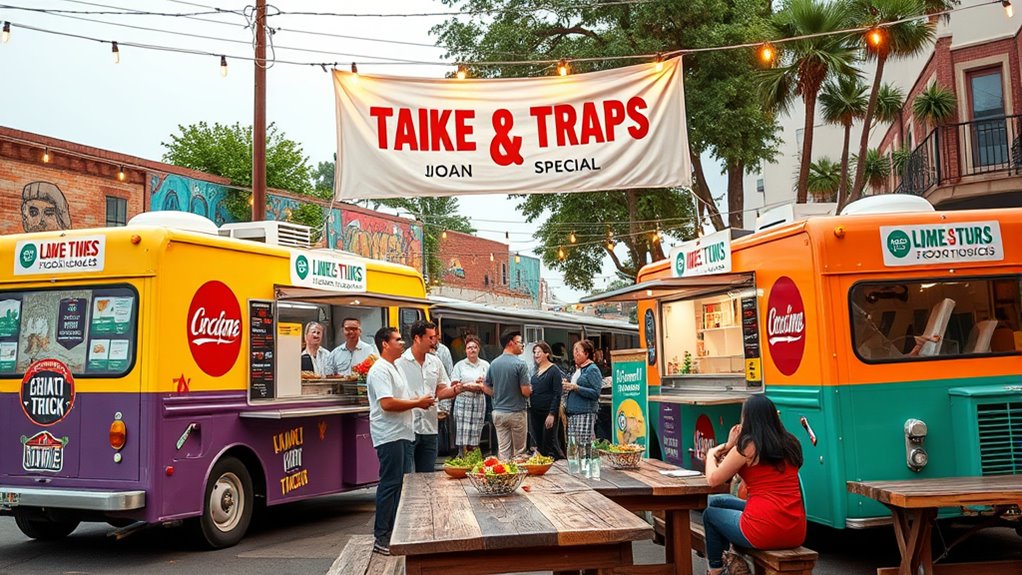
You can create buzz by hosting shared promotional events that highlight both brands, drawing in new customers. Cross-brand packaging strategies, like co-branded containers or merchandise, make your collaboration memorable. Additionally, collaborating on menu items allows you to offer unique experiences that showcase both brands’ strengths. Incorporating brand identity elements into your collaboration efforts helps reinforce brand recognition and loyalty.
Shared Promotional Events
Shared promotional events offer a dynamic way for food trucks and brands to combine their strengths and reach wider audiences. By partnering on events like festivals or themed nights, you can showcase unique menu items through activities such as recipe swaps or live cooking demos. These events encourage engaging experiences that attract new customers and foster community loyalty. To maximize impact, consider these strategies:
- Collaborate on social media tagging to boost online visibility
- Create exclusive menu items or discounts for event attendees
- Incorporate interactive elements like tastings or contests
- Utilizing co-branding opportunities can further enhance brand recognition and credibility.
These tactics not only elevate your brand presence but also encourage attendees to share their experiences, expanding your reach organically. Shared promotional events are a powerful way to build partnerships, strengthen customer relationships, and grow your customer base through memorable, collaborative experiences.
Cross-Brand Packaging Strategies
Cross-brand packaging strategies offer an innovative way for food trucks and brands to extend their reach and reinforce their partnership. By using creative packaging, you can showcase co-branded logos, unique designs, and collaborative messaging that catch customers’ attention. This approach not only enhances visibility but also builds branding consistency across products, making your partnership more memorable. Consider using eco-friendly materials or limited-edition packaging that reflects both brands’ identities, encouraging repeat purchases. Well-designed packaging acts as a mobile billboard, spreading brand awareness in new markets. When executed effectively, it creates a seamless experience that highlights your collaboration’s value. Additionally, incorporating diverse genres and unique storytelling elements in your packaging design can appeal to a broader audience and strengthen customer loyalty. Ultimately, innovative packaging helps differentiate your offerings, reinforces your shared story, and boosts customer engagement with both brands.
Collaborative Menu Items
Collaborative menu items present a dynamic way for food trucks and brands to showcase their partnership directly through the customer’s dining experience. By creating fusion cuisine that combines flavors from both brands, you excite curiosity and broaden appeal. These unique dishes can be promoted through social media integration, encouraging customers to share their experiences and generate buzz. To make the most of this strategy, consider:
- Featuring limited-time fusion dishes that highlight both brands’ identities
- Using social media to showcase behind-the-scenes creation of collaborative items
- Offering exclusive promotions or discounts for customers who try the co-branded menu
This approach not only draws attention but also fosters community engagement, making your collaboration memorable and shareable.
Planning and Executing Successful Joint Events
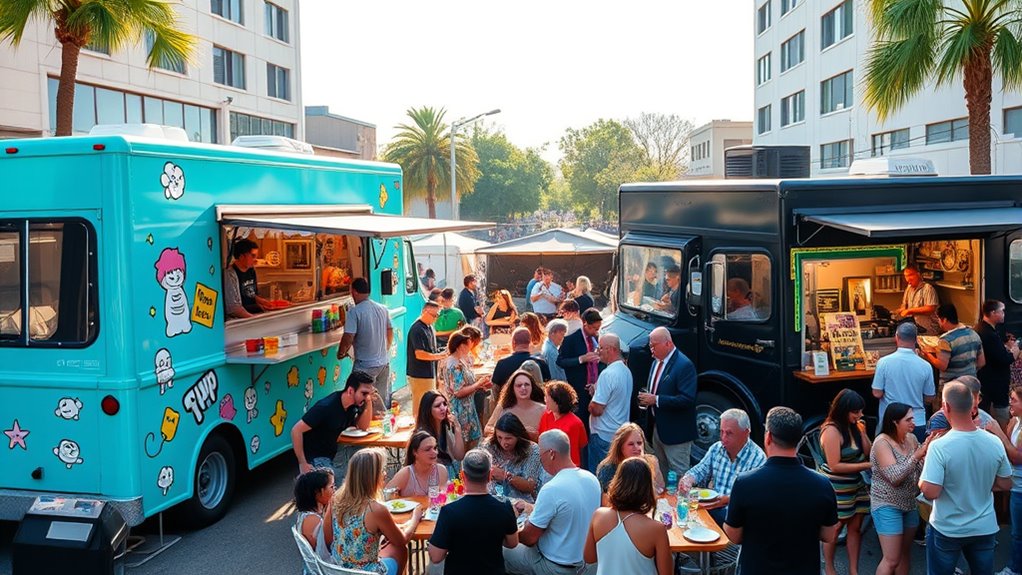
Planning and executing successful joint events with food trucks and brands requires careful coordination and clear communication from the start. You need to align goals, share resources, and establish roles early on. Focus on ingredient sourcing to guarantee quality and consistency across menus, and coordinate staff training to prepare everyone for the event. Clear timelines and responsibilities prevent confusion and delays. Use the table below to organize key tasks:
| Task | Responsibility |
|---|---|
| Menu planning | Collaborate on shared dishes |
| Ingredient sourcing | Coordinate suppliers |
| Staff training | Cross-train staff for roles |
| Marketing and promotion | Joint advertising efforts |
| Event logistics | Setup, staffing, and cleanup |
This approach helps assure smooth execution and a memorable experience for attendees.
Sharing Resources and Reducing Operating Costs
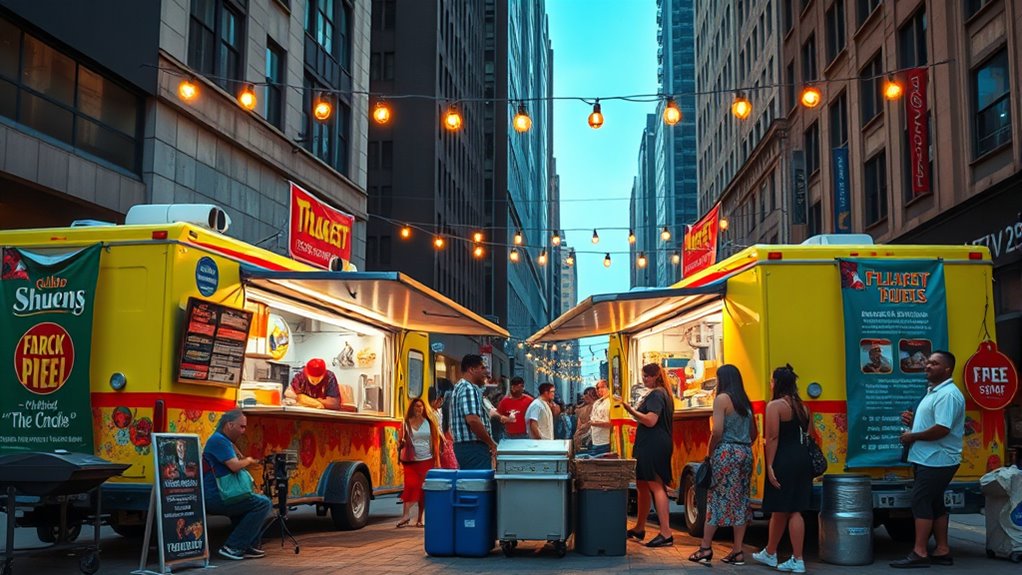
Partnering with food trucks and brands not only enhances your event experience but also opens opportunities to share resources and cut operating costs. By pooling resources, you can streamline ingredient sourcing, reducing expenses and ensuring quality. Sharing staff training sessions benefits everyone by maintaining consistent service standards without extra costs. Collaborating also allows you to:
- Combine purchasing power for bulk ingredient sourcing
- Share equipment and supplies to lower overhead
- Cross-train staff to improve efficiency and flexibility
Additionally, understanding raw food safety practices ensures that all parties maintain high standards and prevent foodborne illnesses. These strategies help you minimize expenses while maintaining high standards. Working together makes it easier to implement cost-effective practices, optimize staffing, and source ingredients more efficiently. Ultimately, sharing resources strengthens your business and boosts profitability without sacrificing quality.
Legal and Logistical Considerations for Partnerships
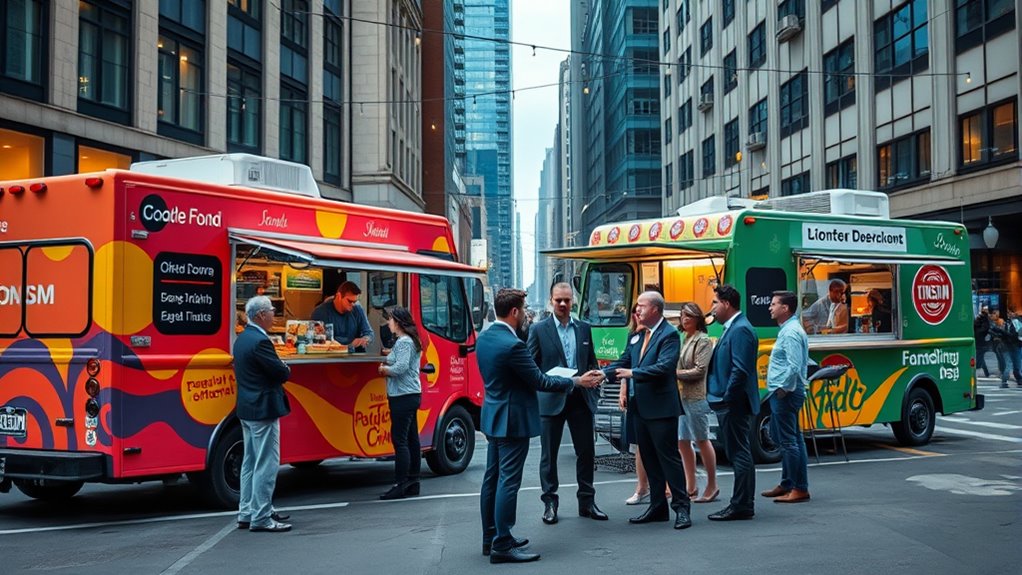
Before entering into food truck and brand partnerships, you need to carefully consider the legal and logistical aspects involved. Liability issues are a key concern; confirm your partnership agreement clearly defines responsibilities and insurance coverage to protect both parties. Licensing requirements are also critical—verify that all necessary permits and health licenses are up-to-date for each location and collaboration. You should also review local regulations regarding operating hours, signage, and branding permissions. Establishing a detailed contract helps prevent misunderstandings over revenue sharing, intellectual property, and liability. Additionally, coordinate logistics such as vehicle access, storage, and scheduling to avoid conflicts. Addressing these legal and logistical considerations upfront ensures a smoother partnership and reduces risks of complications down the line. Regularly reviewing local regulations can help ensure ongoing compliance and avoid potential penalties.
Showcasing Successful Collaborative Campaigns
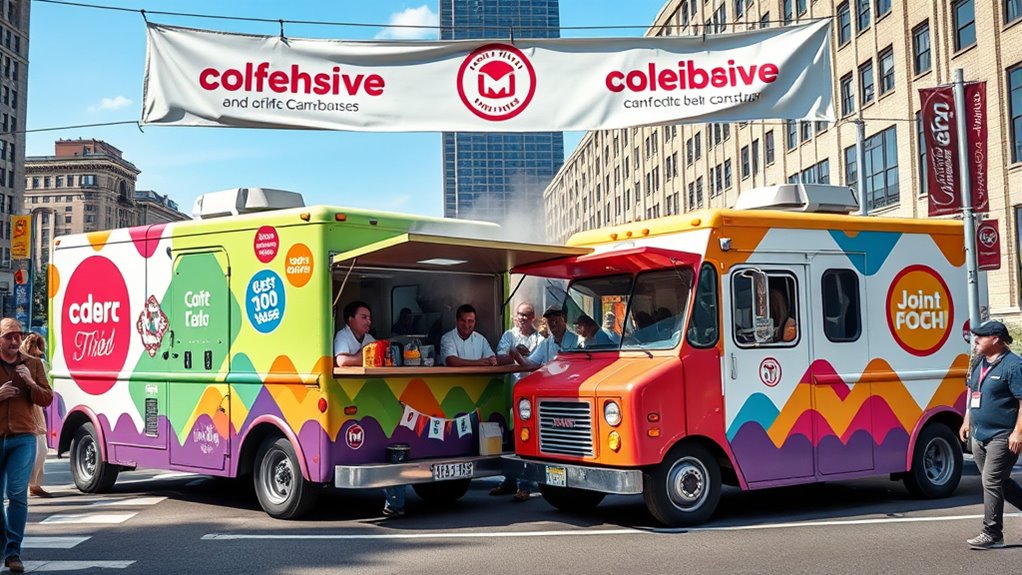
Showcasing successful collaborative campaigns can remarkably boost your food truck’s visibility and credibility. By highlighting key partnerships, you demonstrate your ability to innovate and engage with your community. Focus on campaigns that feature innovative flavors or unique concepts that attract attention. Use social media collaborations to amplify your reach and showcase the excitement behind each initiative. To maximize impact, consider these strategies:
- Share behind-the-scenes content to build anticipation
- Use eye-catching visuals and videos of your collaborative dishes
- Encourage followers to participate in contests or polls related to the campaign
Highlighting these efforts shows your commitment to creativity and partnership, encouraging others to join your journey. Successful collaborations not only bring fresh ideas but also expand your audience and strengthen your brand identity.
Including performance cookies can help you analyze the effectiveness of your campaigns and make data-driven decisions for future collaborations.
Frequently Asked Questions
How Do I Approach Potential Partners Professionally?
When approaching potential partners, you should be professional and confident. Start by researching their branding strategies and how they promote themselves on social media. Reach out with a clear, personalized message that highlights mutual benefits, showcasing your value. Be respectful of their time, and suggest a meeting or call to discuss ideas. Building rapport and demonstrating your commitment will set a positive tone for potential collaboration.
What Are Common Pitfalls in Food Truck Collaborations?
When you consider potential food truck collaborations, watch out for common pitfalls like poor brand alignment, which can confuse customers or dilute your identity. Avoid neglecting social media synergy, as inconsistent messaging can hinder promotion efforts. Be clear about goals, roles, and expectations from the start to prevent misunderstandings. Regular communication ensures both parties stay aligned, maximizing benefits and creating a seamless experience for your shared audience.
How Can I Measure the Success of a Partnership?
To measure your partnership’s success, focus on partnership metrics like sales growth, customer engagement, and brand exposure. Track success indicators such as increased foot traffic, positive customer feedback, and social media reach. You can also analyze repeat business and revenue changes. Regularly review these metrics to assess if your collaboration meets your goals, helping you decide whether to strengthen the partnership or make adjustments for better results.
What Legal Agreements Are Necessary for Collaborations?
Imagine sealing a deal with a handshake, but behind that smile lies a vital contract. You need clear legal agreements for collaborations, including detailed contract negotiations and clauses on branding rights. These documents protect your interests, define responsibilities, and guarantee both parties are aligned. Without them, your partnership could face misunderstandings or disputes. So, always draft solid agreements to safeguard your vision and foster a successful, harmonious collaboration.
How Do I Handle Disagreements During Joint Events?
When disagreements arise during joint events, you should prioritize conflict resolution by communicating openly and calmly. Address issues directly, listen to the other party’s perspective, and seek common ground. Reinforce shared branding goals to maintain a unified front. If needed, revisit your legal agreements to clarify responsibilities. Staying professional and collaborative helps ensure the event runs smoothly and preserves your relationships for future collaborations.
Conclusion
Think of collaboration like a vibrant mosaic—you combine your unique pieces to create a stunning picture. By teaming up with other food trucks and brands, you expand your reach, share resources, and craft unforgettable experiences. When you build strong relationships and plan thoughtfully, your joint efforts become a beautiful tapestry of success. Embrace the power of partnership, and watch your food truck venture flourish like a well-crafted masterpiece.
